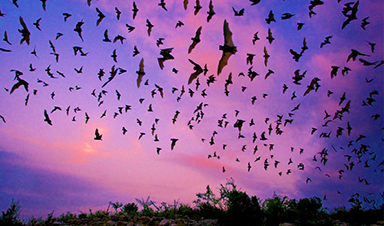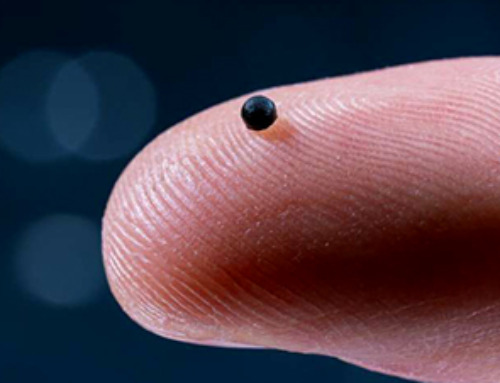A new technology aims to stop wildlife from spreading Ebola, rabies, and other viruses. It could prevent the next pandemic by stopping pathogens from jumping from animals to people.
Imagine a cure that’s as contagious as the disease it fights—a vaccine that could replicate in a host’s body and spread to others nearby, quickly and easily protecting a whole population from microbial attacks. That’s the goal of several teams around the world who are reviving controversial research to develop self-spreading vaccines.
Their hope is to reduce infectious disease transmission among wild animals, thereby lowering the risk that harmful viruses and bacteria can jump from wildlife to humans as many experts believe happened with SARS-CoV-2, the virus that caused the COVID-19 pandemic.
The U.S. Centers for Disease Control and Prevention estimates that 60 percent of all known infectious diseases and 75 percent of new or emerging infectious diseases are zoonotic. Scientists cannot predict why, when, or how new zoonotic diseases will emerge. But when they do, these diseases are often deadly and costly to control. What’s more, many researchers predict that climate change, biodiversity loss, and population growth will accelerate their spread.
Vaccines are a key tool for preventing diseases from spreading, but wild animals are difficult to vaccinate because each one must be located, captured, vaccinated, and released. Self-spreading vaccines offer a solution.
Advances in genomic technology and virology, and a better understanding of disease transmission, have accelerated work that began in the 1980s to make genetically engineered viruses that spread from one animal to another, imparting immunity to disease rather than infection.
Researchers are currently developing self-spreading vaccines for Ebola, bovine tuberculosis, and Lassa fever, a viral disease spread by rats that causes upward of 300,000 infections annually in parts of West Africa. The approach could be expanded to target other zoonotic diseases, including rabies, West Nile virus, Lyme disease, and the plague.
Advocates for self-spreading vaccines say they could revolutionize public health by disrupting infectious disease spread among animals before a zoonotic spillover could occur—potentially preventing the next pandemic.
But others argue that the viruses used in these vaccines could themselves mutate, jump species, or set off a chain reaction with devastating effects across entire ecosystems.
“Once you set something engineered and self-transmissible out into nature, you don’t know what happens to it and where it will go,” says Jonas Sandbrink, a biosecurity researcher at the University of Oxford’s Future of Humanity Institute. “Even if you just start by setting it out into animal populations, part of the genetic elements might find their way back into humans.”
The first, and only, self-spreading vaccine field trial
In 1999, veterinarian José Manuel Sánchez-Vizcaíno led a team of researchers to Isla del Aire, an island off the eastern coast of Spain, to test a self-spreading vaccine against two viral diseases: rabbit hemorrhagic disease and myxomatosis. Although neither disease infects humans, at the time they both had been decimating domestic and wild rabbit populations across China and Europe for several decades.
Traditional vaccines for both diseases were used in domestic rabbits, but trapping and vaccinating wild rabbits, which are notoriously fast-breeding, was an insurmountable task, Sánchez-Vizcaíno explains. He saw huge potential in self-spreading vaccines.
In the laboratory, Sánchez-Vizcaíno, then the director of the Center for Research in Animal Health in Spain, and his team sliced out a gene from the rabbit hemorrhagic disease virus and inserted it into the genome of a mild strain of the myxoma virus, which causes myxomatosis. The final product was a hybrid virus vaccine that protected against both rabbit hemorrhagic disease and myxomatosis. Sánchez-Vizcaíno hypothesized that because the vaccine was similar enough to the original disease-causing myxoma virus, it would still spread among wild rabbits.
On the island the research team captured 147 rabbits, placed microchips in their necks, administered the vaccine to about half of them, and released them all back into the wild. For the next 32 days, the vaccinated and unvaccinated rabbits lived as they normally did. When researchers recaptured micro-chipped rabbits that had not been vaccinated originally, they found that 56 percent of them had antibodies to both viruses, indicating that the vaccine had successfully spread from vaccinated to unvaccinated animals.
The experiment was the first proof-of-concept field test for self-spreading vaccines—and it remains the only one ever attempted.
In 2000, the research team submitted their laboratory and field data to the European Medicines Agency, or EMA, for evaluation and approval for real-world use. The EMA noted technical issues with the vaccine’s safety evaluation and requested that the team decode the myxoma genome, which had not been done before.
Although the team was given two years to comply, the funding body did not provide support for further work, recalls Juan Bárcena, then a Ph.D. student working under Sánchez-Vizcaíno. Bárcena no longer advocates for self-spreading vaccine technology, but he says that data from the laboratory and field trials showed the vaccine was safe and its spread remained confined to the rabbit populations.
Still, Bárcena doubts that the EMA would have ever approved their vaccine given the hesitancy and controversy around genetically modified organisms.
Scott Nuismer, a professor at the University of Idaho who conducts mathematical modelling studies of self-spreading vaccines today, noted that Sánchez-Vizcaíno’s vaccine may have posed more risks than current technologies because the team used a myxoma virus, which is itself deadly, as its vehicle for the vaccine.
After the Isla del Aire field trials, research into self-spreading vaccines went largely dormant. Pharmaceutical companies weren’t interested in investing in research and development for a technology that, by design, would reduce its own profit margins, Sánchez-Vizcaíno speculates.
Vaccines in progress
Renewed interest and funding for the technology popped up around 2016, and today several research groups are developing self-spreading vaccines for animals.
Each of these new vaccines are so-called recombinant viruses. Researchers first identify a protein from the target microbe that serves as an antigen—a substance that triggers immune responses in vaccinated people or animals. Then the researchers select a virus to carry the vaccine and spread it. To do this, researchers capture a few animals from their target population—primates for Ebola, rats for Lassa fever—and isolate a virus that naturally infects those animals. Then they splice in genetic material from the target to create a vaccine.
Each of these vaccines uses a cytomegalovirus, or CMVs, a group that belongs to the herpes family.
CMVs help the researchers overcome several technical challenges. For one, CMVs have large genomes made from double-stranded DNA, which means their genetic code is more stable and can accommodate additional genes from the targeted microbe, says Alec Redwood, a principal research fellow at the University of Western Australia. He conducted self-spreading vaccine research in the early 2000s and is now part of a team developing a CMV-based Lassa fever vaccine.
CMVs also infect a host for life, induce strong immune responses yet do not often cause severe disease. Perhaps most importantly, CMVs are uniquely species-specific; the CMV that spreads among Mastomys natalensis, the rat species that spread Lassa fever, for example, cannot infect any animals other than M. natalensis.
Several small studies have demonstrated that the CMV-based Ebola and bovine tuberculosis vaccines are effective when delivered through traditional injections. Across two trials involving about 50 monkeys, the CMV-based tuberculosis vaccine reduced disease by 68 percent, researchers reported. In a separate study, three out of four monkeys vaccinated with the Ebola vaccine survived direct exposure to Ebola.
Similar experiments with the Lassa virus vaccine are expected to start within the year, according to Redwood. That vaccine will also feature a patent-pending genetic safeguard that allows researchers to control the number of times the vaccine can multiply, thereby limiting its lifetime, Redwood explains.
So far, no one has conducted any field or laboratory studies assessing the impact and safety of these vaccines delivered via the self-spreading mechanism. However, a recent mathematical modelling study reported that if it works as expected, releasing the Lassa fever vaccine could reduce disease transmission among rodents by 95 percent in less than a year.
Risks of self-spreading vaccines
Despite the potential benefits, many experts warn that too little is known about zoonotic disease transmission and viral evolution to accurately predict what might happen if a self-spreading vaccine were released into the wild.
“Our understanding of infectious disease dynamics in wildlife remain for the most part too simple to meaningfully predict the outcome of such an intervention,” says Andrew Peters, an associate professor of wildlife health and pathology at Charles Sturt University in Australia and the president of the Wildlife Disease Association.
Bárcena’s view of self-spreading diseases shifted after he saw how previous animal control strategies involving the intentional release of viruses had unforeseen consequences.
For instance, the myxoma virus that had become such a devastating challenge in Europe arose because a man in France intentionally released the virus in 1952 to keep rabbits out of his home garden. In 2018 Spanish researchers started noticing that a myxoma virus was killing wild hares, a species similar to rabbits. Scientists sequenced its genome and concluded that the myxoma virus had mixed with a poxvirus, enabling it to jump species.
“I don’t know if a mathematical model would have said that 70 years later something like this can happen,” says Bárcena who is now a senior scientist at the Center for Research in Animal Health in Spain.
Filippa Lentzos, a science and international security expert at King’s College London, points out that viruses are genetically unstable and prone to frequent mutations; therefore, a self-spreading vaccine virus could evolve to jump species or cause other unknown consequences in wild and domestic animal populations and, perhaps, even in humans.
Nuismer and Redwood both say it is highly unlikely that a CMV-based vaccine could ever jump species given the virus’s biology. Although the evolutionary factors underlying CMV’s species-specificity are not entirely known, there has never been a documented case in the wild or in a laboratory of a successful cross-species CMV infection.
Another potential risk of self-disseminating vaccines is that ridding wild animals of infectious diseases could disrupt natural population control. The rodents that spread Lassa virus are pests that destroy crops and homes, contaminate stored food and drinking water, and create unsanitary living conditions. If the virus doesn’t affect them anymore, their numbers could skyrocket.
“Say we cure these rodents of Lassa virus and that’s good, that’s great for humanity. Except what if that virus was controlling their population size or something? And then we get a wild expansion of the reservoir rodents,” Nuismer says. “I see this as a much more credible place where we could go wrong … because we could tip the ecology off in a way that would be really unfortunate,” he says.
In addition, there is an emerging understanding that viruses and bacteria exist in complex microbial ecosystems, perhaps keeping each other’s populations in check. The impact of a self-spreading vaccine that wipes out one specific virus might have unknown consequences.
“Dramatically shifting the balance by attempting to eradicate or reduce an endemic virus in nature could risk the emergence of other pathogens which impact both the wildlife species themselves, as well as people and our domestic animals,” says Peters.
To mitigate these risks, Nuismer and Redwood envision a progression of testing setups that moves slowly from lab-controlled trials to large-scale enclosures, perhaps on an island like Sánchez-Vizcaíno and his team did more than 20 years ago.
The long road ahead
Most researchers agree that self-spreading vaccines could never be applied to human populations, because universal informed consent would never be achieved.
News
Vision can be rebooted in adults with amblyopia, study suggests
Temporarily anesthetizing the retina briefly reverts the activity of the visual system to that observed in early development and enables growth of responses to the amblyopic eye, new research shows. In the common vision [...]
Ultrasound-activated Nanoparticles Kill Liver Cancer and Activate Immune System
A new ultrasound-guided nanotherapy wipes out liver tumors while training the immune system to keep them from coming back. The study, published in Nano Today, introduces a biodegradable nanoparticle system that combines sonodynamic therapy and cell [...]
Magnetic nanoparticles that successfully navigate complex blood vessels may be ready for clinical trials
Every year, 12 million people worldwide suffer a stroke; many die or are permanently impaired. Currently, drugs are administered to dissolve the thrombus that blocks the blood vessel. These drugs spread throughout the entire [...]
Reviving Exhausted T Cells Sparks Powerful Cancer Tumor Elimination
Scientists have discovered how tumors secretly drain the energy from T cells—the immune system’s main cancer fighters—and how blocking that process can bring them back to life. The team found that cancer cells use [...]
Very low LDL-cholesterol correlates to fewer heart problems after stroke
Brigham and Women's Hospital's TIMI Study Group reports that in patients with prior ischemic stroke, very low achieved LDL-cholesterol correlated with fewer major adverse cardiovascular events and fewer recurrent strokes, without an apparent increase [...]
“Great Unified Microscope” Reveals Hidden Micro and Nano Worlds Inside Living Cells
University of Tokyo researchers have created a powerful new microscope that captures both forward- and back-scattered light at once, letting scientists see everything from large cell structures to tiny nanoscale particles in a single shot. Researchers [...]
Breakthrough Alzheimer’s Drug Has a Hidden Problem
Researchers in Japan found that although the Alzheimer’s drug lecanemab successfully removes amyloid plaques from the brain, it does not restore the brain’s waste-clearing system within the first few months of treatment. The study suggests that [...]
Concerning New Research Reveals Colon Cancer Is Skyrocketing in Adults Under 50
Colorectal cancer is striking younger adults at alarming rates, driven by lifestyle and genetic factors. Colorectal cancer (CRC) develops when abnormal cells grow uncontrollably in the colon or rectum, forming tumors that can eventually [...]
Scientists Discover a Natural, Non-Addictive Way To Block Pain That Could Replace Opioids
Scientists have discovered that the body can naturally dull pain through its own localized “benzodiazepine-like” peptides. A groundbreaking study led by a University of Leeds scientist has unveiled new insights into how the body manages pain, [...]
GLP-1 Drugs Like Ozempic Work, but New Research Reveals a Major Catch
Three new Cochrane reviews find evidence that GLP-1 drugs lead to clinically meaningful weight loss, though industry-funded studies raise concerns. Three new reviews from Cochrane have found that GLP-1 medications can lead to significant [...]
How a Palm-Sized Laser Could Change Medicine and Manufacturing
Researchers have developed an innovative and versatile system designed for a new generation of short-pulse lasers. Lasers that produce extremely short bursts of light are known for their remarkable precision, making them indispensable tools [...]
New nanoparticles stimulate the immune system to attack ovarian tumors
Cancer immunotherapy, which uses drugs that stimulate the body’s immune cells to attack tumors, is a promising approach to treating many types of cancer. However, it doesn’t work well for some tumors, including ovarian [...]
New Drug Kills Cancer 20,000x More Effectively With No Detectable Side Effects
By restructuring a common chemotherapy drug, scientists increased its potency by 20,000 times. In a significant step forward for cancer therapy, researchers at Northwestern University have redesigned the molecular structure of a well-known chemotherapy drug, greatly [...]
Lipid nanoparticles discovered that can deliver mRNA directly into heart muscle cells
Cardiovascular disease continues to be the leading cause of death worldwide. But advances in heart-failure therapeutics have stalled, largely due to the difficulty of delivering treatments at the cellular level. Now, a UC Berkeley-led [...]
The basic mechanisms of visual attention emerged over 500 million years ago, study suggests
The brain does not need its sophisticated cortex to interpret the visual world. A new study published in PLOS Biology demonstrates that a much older structure, the superior colliculus, contains the necessary circuitry to perform the [...]
AI Is Overheating. This New Technology Could Be the Fix
Engineers have developed a passive evaporative cooling membrane that dramatically improves heat removal for electronics and data centers Engineers at the University of California San Diego have created an innovative cooling system designed to greatly enhance [...]





















